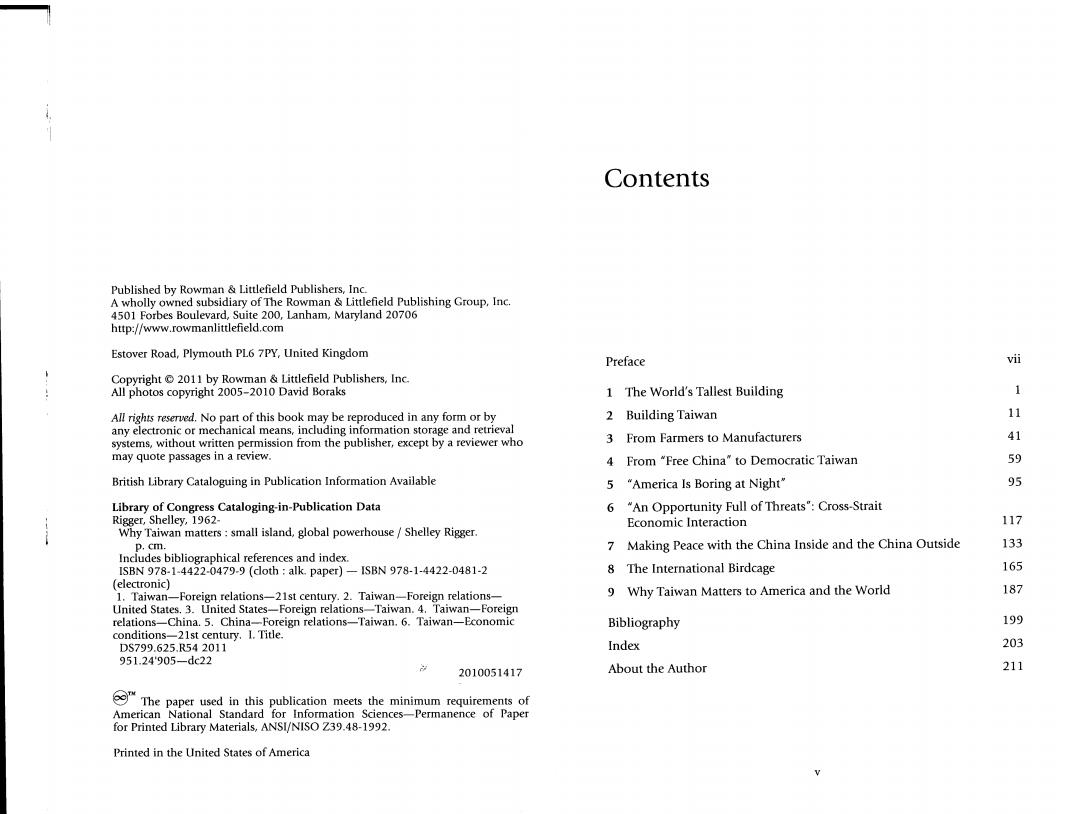
Contents Published by Rowman Littlefield Publishers,Inc A wholly owned subsidiary of The Rowman Littlefield Publishing Group,Inc. 4501 Forbes Boulevard,Suite 200,Lanham,Maryland 20706 http://www.rowmanlittlefield.com Estover Road,Plymouth PL6 7PY,United Kingdom Preface vii Copyright 2011 by Rowman Littlefield Publishers,Inc. All photos copyright 2005-2010 David Boraks 1 The World's Tallest Building All rights reserved.No part of this book may be reproduced in any form or by 2 Building Taiwan 11 any electronic or mechanical means,including information storage and retrieval systems,without written permission from the publisher,except by a reviewer who 3 From Farmers to Manufacturers 41 may quote passages in a review. 4 From "Free China"to Democratic Taiwan 59 British Library Cataloguing in Publication Information Available 5 "America Is Boring at Night" 95 Library of Congress Cataloging-in-Publication Data 6 "An Opportunity Full of Threats":Cross-Strait Rigger,Shelley,1962- Economic Interaction 117 Why Taiwan matters:small island,global powerhouse Shelley Rigger p.cm. 1 Making Peace with the China Inside and the China Outside 133 Includes bibliographical references and index. ISBN978-1-4422-0479-9(doth:alk.paper)-ISBN978-1-4422-0481-2 8 The International Birdcage 165 (electronic) 1.Taiwan-Foreign relations-21st century.2.Taiwan-Foreign relations- 9 Why Taiwan Matters to America and the World 187 United States.3.United States-Foreign relations-Taiwan.4.Taiwan-Foreign relations-China.5.China-Foreign relations-Taiwan.6.Taiwan-Economic Bibliography 199 conditions-21st century.I.Title. DS799.625.R542011 Index 203 951.24905-dc22 2010051417 About the Author 211 The paper used in this publication meets the minimum requirements of American National Standard for Information Sciences-Permanence of Paper for Printed Library Materials,ANSI/NISO Z39.48-1992. Printed in the United States of America

Preface Why Taiwan Matters is a book I have wanted to write for a long time.It answers the two questions I am asked most often about my work:What makes Taiwan so interesting to you?And,why is Taiwan such a big deal in U.S.-China relations? I hope when you finish reading the book the first question will be an- swered.My goal is to give you an inkling of the excitement I feel every time I step off a plane at the Taoyuan International Airport.I felt that excitement for the first time in 1983 when I was a twenty-one-year-old college student embarking on a summer research project.I will never forget how bewilder- ing,terrifying,and exhilarating it was to find myself standing alone with my suitcase on a hot,dusty sidewalk in Taipei,armed with nothing more than an envelope of traveler's checks,a couple of telephone numbers,and four semesters of Chinese language instruction.Today,arriving in Taipei feels like returning to a second home-but it is a home where time accelerates and people cram three days of living into every twenty-four hours. The second question-why does Taiwan matter so much to U.S.-China relations?-is more complicated.Taiwan matters to the United States and other countries because it is an economic powerhouse that supplies much of our information-technology equipment and because it occupies a strate- gic niche in the Western Pacific.It is unique in the world in having all the attributes of a state-territory,population,government-except recogni- tion by others.The People's Republic of China insists that history makes Taiwan part of China,and because the government in Beijing is the rec- ognized Chinese state,it should rule the island.Few Taiwanese share that view,but there is a lively debate about how to fend off Beijing's attentions Navigating between the two sides-developing amicable relations with vii
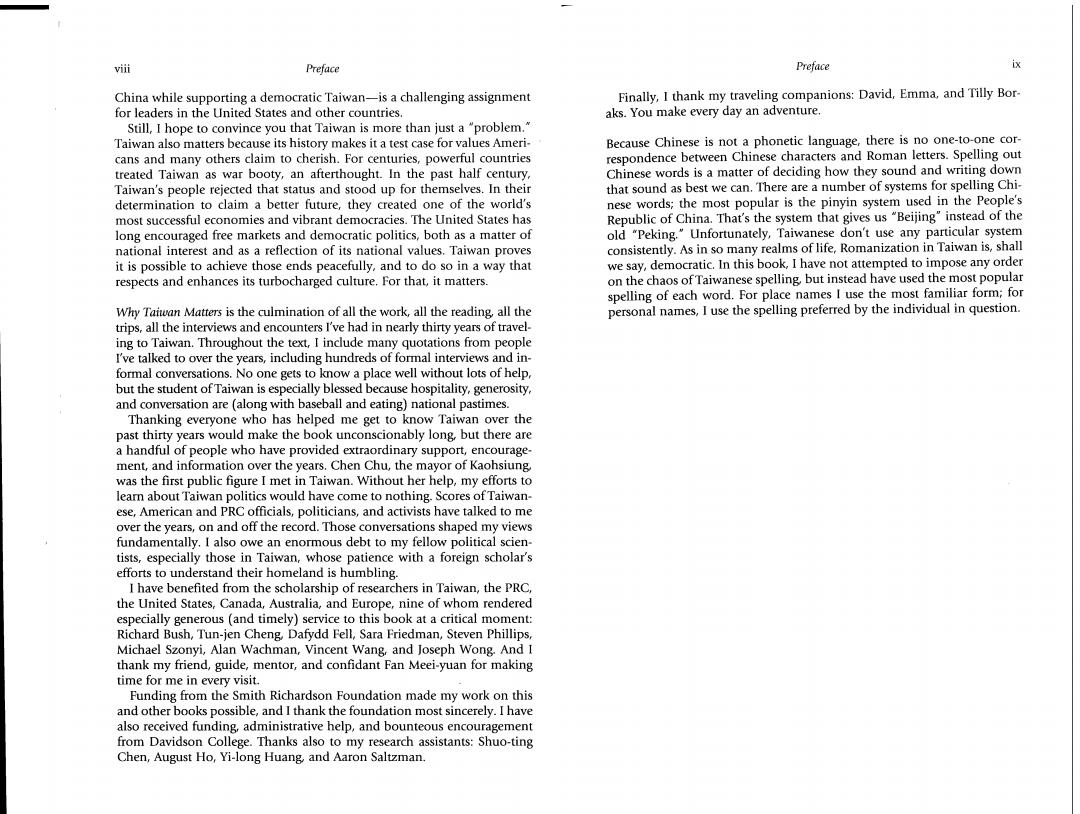
vin Preface Preface ix China while supporting a democratic Taiwan-is a challenging assignment Finally,I thank my traveling companions:David,Emma,and Tilly Bor- for leaders in the United States and other countries aks.You make every day an adventure. Still,I hope to convince you that Taiwan is more than just a "problem." Taiwan also matters because its history makes it a test case for values Ameri- Because Chinese is not a phonetic language,there is no one-to-one cor- cans and many others claim to cherish.For centuries,powerful countries respondence between Chinese characters and Roman letters.Spelling out treated Taiwan as war booty,an afterthought.In the past half century, Chinese words is a matter of deciding how they sound and writing down Taiwan's people rejected that status and stood up for themselves.In their that sound as best we can.There are a number of systems for spelling Chi- determination to claim a better future,they created one of the world's nese words;the most popular is the pinyin system used in the People's most successful economies and vibrant democracies.The United States has Republic of China.That's the system that gives us "Beijing"instead of the long encouraged free markets and democratic politics,both as a matter of old "Peking."Unfortunately,Taiwanese don't use any particular system national interest and as a reflection of its national values.Taiwan proves consistently.As in so many realms of life,Romanization in Taiwan is,shall it is possible to achieve those ends peacefully,and to do so in a way that we say,democratic.In this book,I have not attempted to impose any order respects and enhances its turbocharged culture.For that,it matters. on the chaos of Taiwanese spelling,but instead have used the most popular spelling of each word.For place names I use the most familiar form;for Why Taitan Matters is the culmination of all the work,all the reading,all the personal names,I use the spelling preferred by the individual in question. trips,all the interviews and encounters I've had in nearly thirty years of travel- ing to Taiwan.Throughout the text,I include many quotations from people I've talked to over the years,indluding hundreds of formal interviews and in- formal conversations.No one gets to know a place well without lots of help, but the student of Taiwan is especially blessed because hospitality,generosity, and conversation are (along with baseball and eating)national pastimes. Thanking everyone who has helped me get to know Taiwan over the past thirty years would make the book unconscionably long,but there are a handful of people who have provided extraordinary support,encourage- ment,and information over the years.Chen Chu,the mayor of Kaohsiung was the first public figure I met in Taiwan.Without her help,my efforts to learn about Taiwan politics would have come to nothing.Scores of Taiwan- ese,American and PRC officials,politicians,and activists have talked to me over the years,on and off the record.Those conversations shaped my views fundamentally.I also owe an enormous debt to my fellow political scien- tists,especially those in Taiwan,whose patience with a foreign scholar's efforts to understand their homeland is humbling. I have benefited from the scholarship of researchers in Taiwan,the PRC, the United States,Canada,Australia,and Europe,nine of whom rendered especially generous (and timely)service to this book at a critical moment: Richard Bush,Tun-jen Cheng,Dafydd Fell,Sara Friedman,Steven Phillips Michael Szonyi,Alan Wachman,Vincent Wang,and Joseph Wong.And I thank my friend,guide,mentor,and confidant Fan Meei-yuan for making time for me in every visit. Funding from the Smith Richardson Foundation made my work on this and other books possible,and I thank the foundation most sincerely.I have also received funding,administrative help,and bounteous encouragement from Davidson College.Thanks also to my research assistants:Shuo-ting Chen,August Ho,Yi-long Huang,and Aaron Saltzman
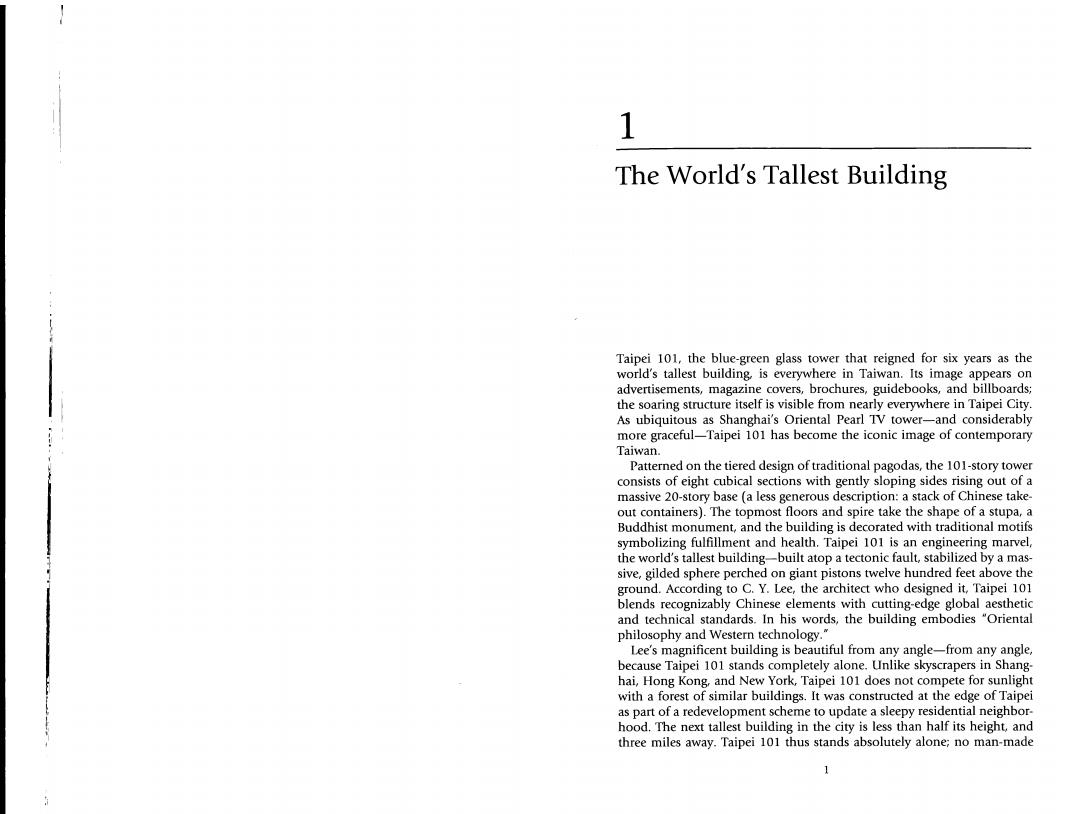
1 The World's Tallest Building Taipei 101,the blue-green glass tower that reigned for six years as the world's tallest building,is everywhere in Taiwan.Its image appears on advertisements,magazine covers,brochures,guidebooks,and billboards; the soaring structure itself is visible from nearly everywhere in Taipei City. As ubiquitous as Shanghai's Oriental Pearl TV tower-and considerably more graceful-Taipei 101 has become the iconic image of contemporary Taiwan. Patterned on the tiered design of traditional pagodas,the 101-story tower consists of eight cubical sections with gently sloping sides rising out of a massive 20-story base (a less generous description:a stack of Chinese take- out containers).The topmost floors and spire take the shape of a stupa,a Buddhist monument,and the building is decorated with traditional motifs symbolizing fulfillment and health.Taipei 101 is an engineering marvel, the world's tallest building-built atop a tectonic fault,stabilized by a mas- sive,gilded sphere perched on giant pistons twelve hundred feet above the ground.According to C.Y.Lee,the architect who designed it,Taipei 101 blends recognizably Chinese elements with cutting-edge global aesthetic and technical standards.In his words,the building embodies "Oriental philosophy and Western technology. Lee's magnificent building is beautiful from any angle-from any angle, because Taipei 101 stands completely alone.Unlike skyscrapers in Shang- hai,Hong Kong,and New York,Taipei 101 does not compete for sunlight with a forest of similar buildings.It was constructed at the edge of Taipei as part of a redevelopment scheme to update a sleepy residential neighbor- hood.The next tallest building in the city is less than half its height,and three miles away.Taipei 101 thus stands absolutely alone;no man-made 1
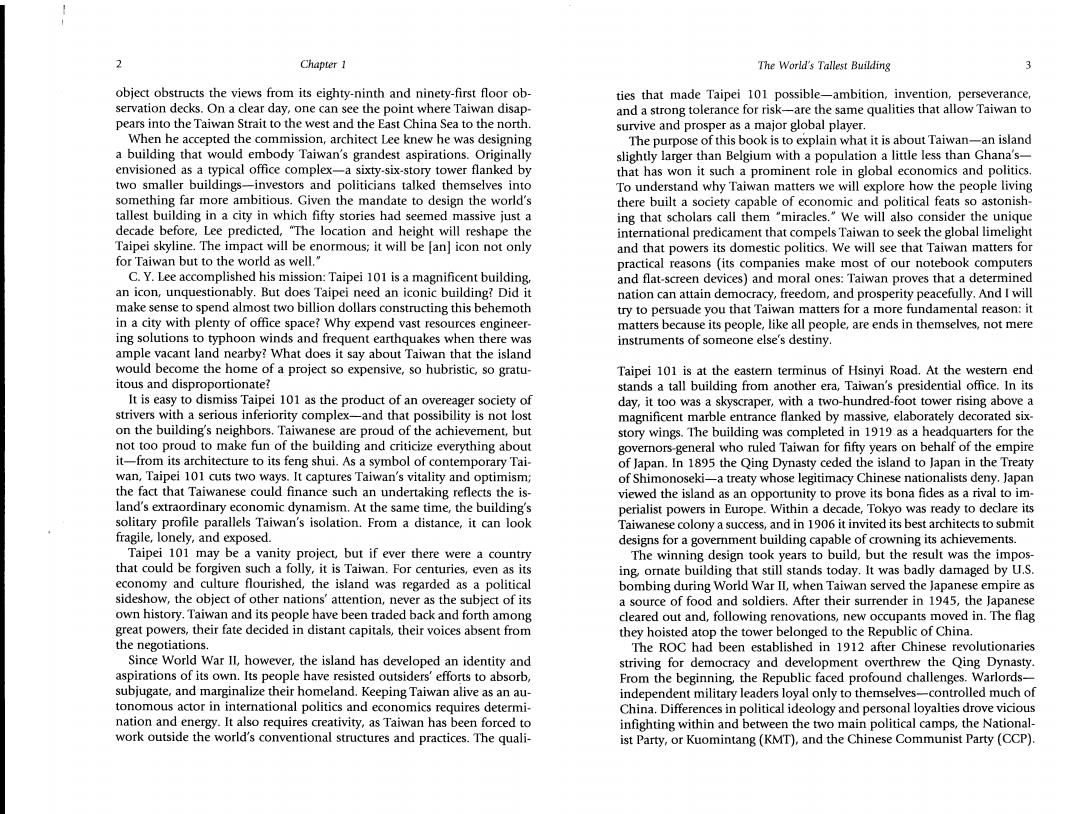
2 Chapter 1 The World's Tallest Building 3 object obstructs the views from its eighty-ninth and ninety-first floor ob- ties that made Taipei 101 possible-ambition,invention,perseverance, servation decks.On a clear day,one can see the point where Taiwan disap- and a strong tolerance for risk-are the same qualities that allow Taiwan to pears into the Taiwan Strait to the west and the East China Sea to the north. survive and prosper as a major global player. When he accepted the commission,architect Lee knew he was designing The purpose of this book is to explain what it is about Taiwan-an island a building that would embody Taiwan's grandest aspirations.Originally slightly larger than Belgium with a population a little less than Ghanas- envisioned as a typical office complex-a sixty-six-story tower flanked by that has won it such a prominent role in global economics and politics. two smaller buildings-investors and politicians talked themselves into To understand why Taiwan matters we will explore how the people living something far more ambitious.Given the mandate to design the world's there built a society capable of economic and political feats so astonish- tallest building in a city in which fifty stories had seemed massive just a ing that scholars call them "miracles."We will also consider the unique decade before,Lee predicted,"The location and height will reshape the international predicament that compels Taiwan to seek the global limelight Taipei skyline.The impact will be enormous;it will be [an]icon not only and that powers its domestic politics.We will see that Taiwan matters for for Taiwan but to the world as well." practical reasons (its companies make most of our notebook computers C.Y.Lee accomplished his mission:Taipei 101 is a magnificent building, and flat-screen devices)and moral ones:Taiwan proves that a determined an icon,unquestionably.But does Taipei need an iconic building?Did it nation can attain democracy,freedom,and prosperity peacefully.And I will make sense to spend almost two billion dollars constructing this behemoth try to persuade you that Taiwan matters for a more fundamental reason:it in a city with plenty of office space?Why expend vast resources engineer- matters because its people,like all people,are ends in themselves,not mere ing solutions to typhoon winds and frequent earthquakes when there was instruments of someone else's destiny. ample vacant land nearby?What does it say about Taiwan that the island would become the home of a project so expensive,so hubristic,so gratu- Taipei 101 is at the eastern terminus of Hsinyi Road.At the western end itous and disproportionate? stands a tall building from another era,Taiwan's presidential office.In its It is easy to dismiss Taipei 101 as the product of an overeager society of day,it too was a skyscraper,with a two-hundred-foot tower rising above a strivers with a serious inferiority complex-and that possibility is not lost magnificent marble entrance flanked by massive,elaborately decorated six- on the building's neighbors.Taiwanese are proud of the achievement,but story wings.The building was completed in 1919 as a headquarters for the not too proud to make fun of the building and criticize everything about governors-general who ruled Taiwan for fifty years on behalf of the empire it-from its architecture to its feng shui.As a symbol of contemporary Tai- of Japan.In 1895 the Qing Dynasty ceded the island to Japan in the Treaty wan,Taipei 101 cuts two ways.It captures Taiwan's vitality and optimism; of Shimonoseki-a treaty whose legitimacy Chinese nationalists deny.Japan the fact that Taiwanese could finance such an undertaking reflects the is- viewed the island as an opportunity to prove its bona fides as a rival to im- land's extraordinary economic dynamism.At the same time,the building's perialist powers in Europe.Within a decade,Tokyo was ready to declare its solitary profile parallels Taiwan's isolation.From a distance,it can look Taiwanese colony a success,and in 1906 it invited its best architects to submit fragile,lonely,and exposed. designs for a government building capable of crowning its achievements. Taipei 101 may be a vanity project,but if ever there were a country The winning design took years to build,but the result was the impos- that could be forgiven such a folly,it is Taiwan.For centuries,even as its ing ornate building that still stands today.It was badly damaged by U.S. economy and culture flourished,the island was regarded as a political bombing during World War Il,when Taiwan served the Japanese empire as sideshow,the object of other nations'attention,never as the subject of its a source of food and soldiers.After their surrender in 1945,the Japanese own history.Taiwan and its people have been traded back and forth among cleared out and,following renovations,new occupants moved in.The flag great powers,their fate decided in distant capitals,their voices absent from they hoisted atop the tower belonged to the Republic of China. the negotiations. The ROC had been established in 1912 after Chinese revolutionaries Since World War II,however,the island has developed an identity and striving for democracy and development overthrew the Qing Dynasty. aspirations of its own.Its people have resisted outsiders'efforts to absorb, From the beginning,the Republic faced profound challenges.Warlords- subjugate,and marginalize their homeland.Keeping Taiwan alive as an au- independent military leaders loyal only to themselves-controlled much of tonomous actor in international politics and economics requires determi- China.Differences in political ideology and personal loyalties drove vicious nation and energy.It also requires creativity,as Taiwan has been forced to infighting within and between the two main political camps,the National- work outside the world's conventional structures and practices.The quali- ist Party,or Kuomintang(KMT),and the Chinese Communist Party (CCP)
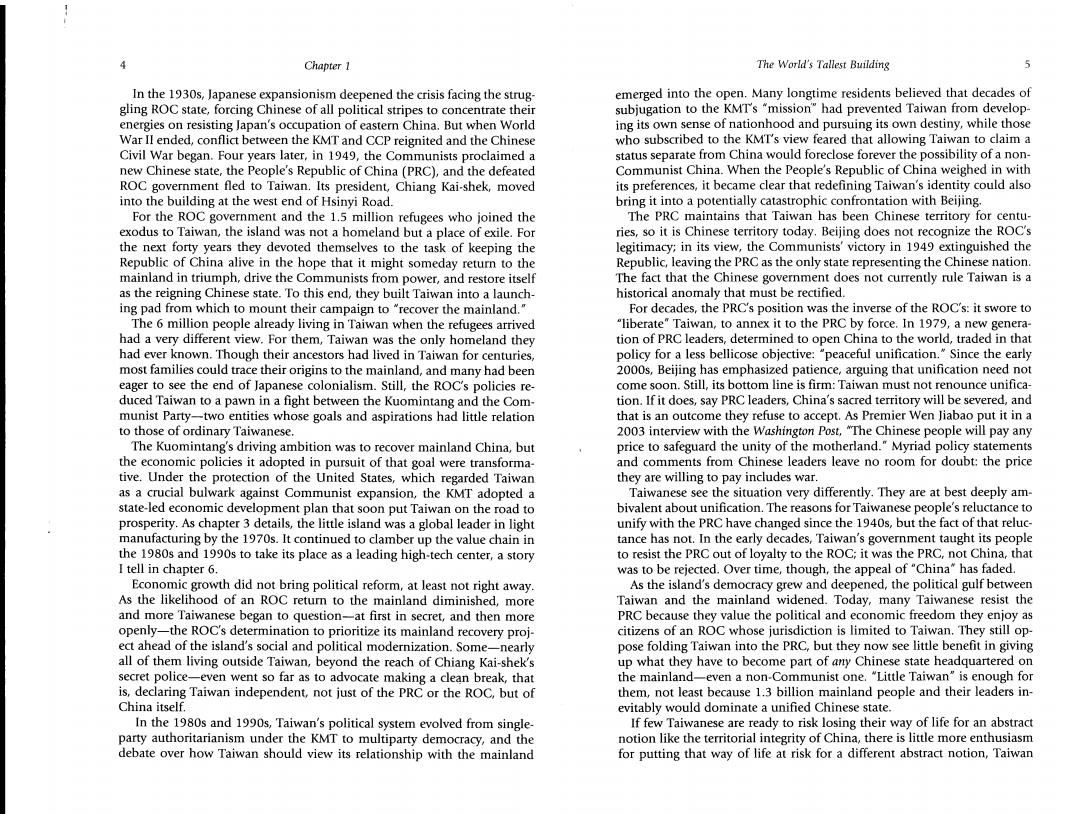
Chapter 1 The World's Tallest Building 5 In the 1930s,Japanese expansionism deepened the crisis facing the strug- emerged into the open.Many longtime residents believed that decades of gling ROC state,forcing Chinese of all political stripes to concentrate their subjugation to the KMT's "mission"had prevented Taiwan from develop- energies on resisting Japan's occupation of eastern China.But when World ing its own sense of nationhood and pursuing its own destiny,while those War Il ended,conflict between the KMT and CCP reignited and the Chinese who subscribed to the KMT's view feared that allowing Taiwan to claim a Civil War began.Four years later,in 1949,the Communists proclaimed a status separate from China would foreclose forever the possibility of a non- new Chinese state,the People's Republic of China (PRC),and the defeated Communist China.When the People's Republic of China weighed in with ROC government fled to Taiwan.Its president,Chiang Kai-shek,moved its preferences,it became clear that redefining Taiwan's identity could also into the building at the west end of Hsinyi Road. bring it into a potentially catastrophic confrontation with Beijing. For the ROC government and the 1.5 million refugees who joined the The PRC maintains that Taiwan has been Chinese territory for centu- exodus to Taiwan,the island was not a homeland but a place of exile.For ries,so it is Chinese territory today.Beijing does not recognize the ROC's the next forty years they devoted themselves to the task of keeping the legitimacy;in its view,the Communists'victory in 1949 extinguished the Republic of China alive in the hope that it might someday return to the Republic,leaving the PRC as the only state representing the Chinese nation. mainland in triumph,drive the Communists from power,and restore itself The fact that the Chinese government does not currently rule Taiwan is a as the reigning Chinese state.To this end,they built Taiwan into a launch historical anomaly that must be rectified. ing pad from which to mount their campaign to "recover the mainland." For decades,the PRC's position was the inverse of the ROC's:it swore to The 6 million people already living in Taiwan when the refugees arrived "liberate"Taiwan,to annex it to the PRC by force.In 1979,a new genera- had a very different view.For them,Taiwan was the only homeland they tion of PRC leaders,determined to open China to the world,traded in that had ever known.Though their ancestors had lived in Taiwan for centuries, policy for a less bellicose objective:"peaceful unification."Since the early most families could trace their origins to the mainland,and many had been 2000s,Beijing has emphasized patience,arguing that unification need not eager to see the end of Japanese colonialism.Still,the ROC's policies re- come soon.Still,its bottom line is firm:Taiwan must not renounce unifica- duced Taiwan to a pawn in a fight between the Kuomintang and the Com- tion.If it does,say PRC leaders,China's sacred territory will be severed,and munist Party-two entities whose goals and aspirations had little relation that is an outcome they refuse to accept.As Premier Wen Jiabao put it in a to those of ordinary Taiwanese 2003 interview with the Washington Post,"The Chinese people will pay any The Kuomintang's driving ambition was to recover mainland China,but price to safeguard the unity of the motherland."Myriad policy statements the economic policies it adopted in pursuit of that goal were transforma- and comments from Chinese leaders leave no room for doubt:the price tive.Under the protection of the United States,which regarded Taiwan they are willing to pay includes war. as a crucial bulwark against Communist expansion,the KMT adopted a Taiwanese see the situation very differently.They are at best deeply am- state-led economic development plan that soon put Taiwan on the road to bivalent about unification.The reasons for Taiwanese people's reluctance to prosperity.As chapter 3 details,the little island was a global leader in light unify with the PRC have changed since the 1940s,but the fact of that reluc- manufacturing by the 1970s.It continued to clamber up the value chain in tance has not.In the early decades,Taiwan's government taught its people the 1980s and 1990s to take its place as a leading high-tech center,a story to resist the PRC out of loyalty to the ROC;it was the PRC,not China,that Itell in chapter 6. was to be rejected.Over time,though,the appeal of"China"has faded. Economic growth did not bring political reform,at least not right away. As the island's democracy grew and deepened,the political gulf between As the likelihood of an ROC return to the mainland diminished,more Taiwan and the mainland widened.Today,many Taiwanese resist the and more Taiwanese began to question-at first in secret,and then more PRC because they value the political and economic freedom they enjoy as openly-the ROC's determination to prioritize its mainland recovery proj- citizens of an ROC whose jurisdiction is limited to Taiwan.They still op- ect ahead of the island's social and political modernization.Some-nearly pose folding Taiwan into the PRC,but they now see little benefit in giving all of them living outside Taiwan,beyond the reach of Chiang Kai-shek's up what they have to become part of any Chinese state headquartered on secret police-even went so far as to advocate making a clean break,that the mainland-even a non-Communist one."Little Taiwan"is enough for is,declaring Taiwan independent,not just of the PRC or the ROC,but of them,not least because 1.3 billion mainland people and their leaders in- China itself. evitably would dominate a unified Chinese state. In the 1980s and 1990s,Taiwan's political system evolved from single- If few Taiwanese are ready to risk losing their way of life for an abstract party authoritarianism under the KMT to multiparty democracy,and the notion like the territorial integrity of China,there is little more enthusiasm debate over how Taiwan should view its relationship with the mainland for putting that way of life at risk for a different abstract notion,Taiwan
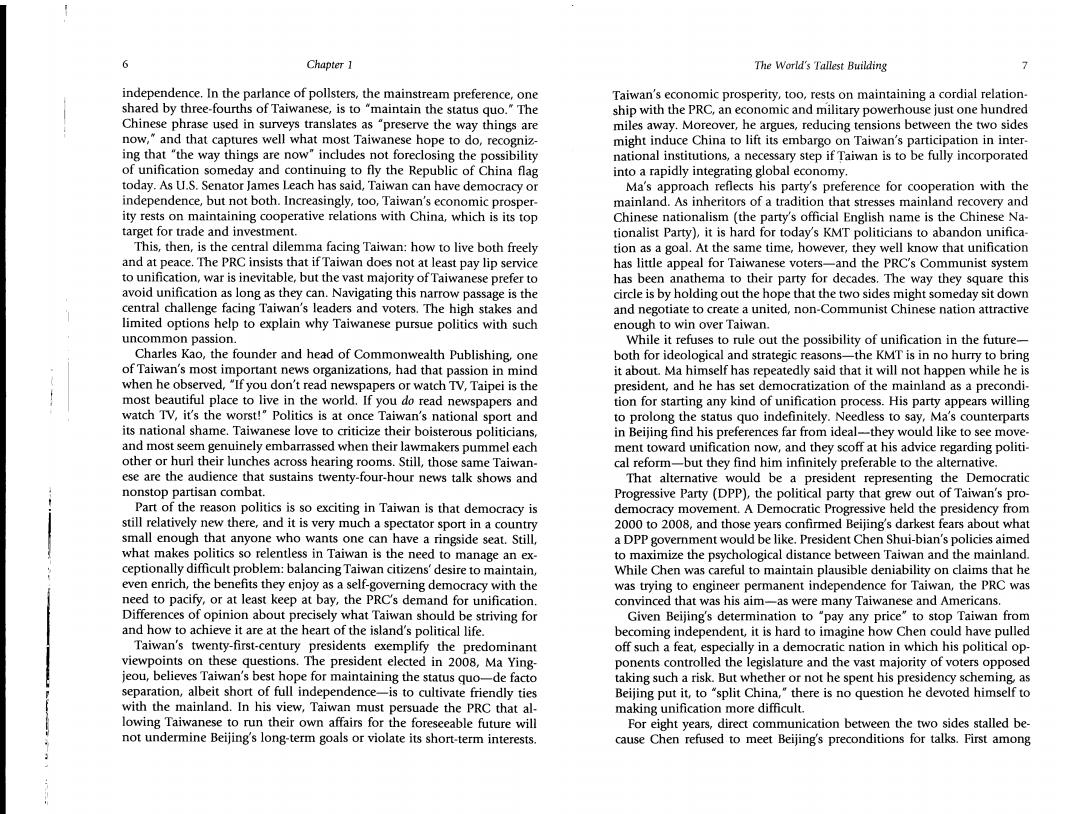
6 Chapter 1 The World's Tallest Building 7 independence.In the parlance of pollsters,the mainstream preference,one Taiwan's economic prosperity,too,rests on maintaining a cordial relation- shared by three-fourths of Taiwanese,is to "maintain the status quo."The ship with the PRC,an economic and military powerhouse just one hundred Chinese phrase used in surveys translates as "preserve the way things are miles away.Moreover,he argues,reducing tensions between the two sides now,and that captures well what most Taiwanese hope to do,recogniz- might induce China to lift its embargo on Taiwan's participation in inter- ing that "the way things are now"includes not foreclosing the possibility national institutions,a necessary step if Taiwan is to be fully incorporated of unification someday and continuing to fly the Republic of China flag into a rapidly integrating global economy. today.As U.S.Senator James Leach has said,Taiwan can have democracy or Ma's approach reflects his party's preference for cooperation with the independence,but not both.Increasingly,too,Taiwan's economic prosper- mainland.As inheritors of a tradition that stresses mainland recovery and ity rests on maintaining cooperative relations with China,which is its top Chinese nationalism (the party's official English name is the Chinese Na- target for trade and investment. tionalist Party),it is hard for today's KMT politicians to abandon unifica- This,then,is the central dilemma facing Taiwan:how to live both freely tion as a goal.At the same time,however,they well know that unification and at peace.The PRC insists that if Taiwan does not at least pay lip service has little appeal for Taiwanese voters-and the PRC's Communist system to unification,war is inevitable,but the vast majority of Taiwanese prefer to has been anathema to their party for decades.The way they square this avoid unification as long as they can.Navigating this narrow passage is the circle is by holding out the hope that the two sides might someday sit down central challenge facing Taiwan's leaders and voters.The high stakes and and negotiate to create a united,non-Communist Chinese nation attractive limited options help to explain why Taiwanese pursue politics with such enough to win over Taiwan. uncommon passion. While it refuses to rule out the possibility of unification in the future- Charles Kao,the founder and head of Commonwealth Publishing,one both for ideological and strategic reasons-the KMT is in no hurry to bring of Taiwan's most important news organizations,had that passion in mind it about.Ma himself has repeatedly said that it will not happen while he is when he observed,"If you don't read newspapers or watch TV,Taipei is the president,and he has set democratization of the mainland as a precondi- most beautiful place to live in the world.If you do read newspapers and tion for starting any kind of unification process.His party appears willing watch TV,it's the worst!"Politics is at once Taiwan's national sport and to prolong the status quo indefinitely.Needless to say,Ma's counterparts its national shame.Taiwanese love to criticize their boisterous politicians, in Beijing find his preferences far from ideal-they would like to see move- and most seem genuinely embarrassed when their lawmakers pummel each ment toward unification now,and they scoff at his advice regarding politi- other or hurl their lunches across hearing rooms.Still,those same Taiwan- cal reform-but they find him infinitely preferable to the alternative. ese are the audience that sustains twenty-four-hour news talk shows and That alternative would be a president representing the Democratic nonstop partisan combat. Progressive Party (DPP),the political party that grew out of Taiwan's pro- Part of the reason politics is so exciting in Taiwan is that democracy is democracy movement.A Democratic Progressive held the presidency from still relatively new there,and it is very much a spectator sport in a country 2000 to 2008,and those years confirmed Beijing's darkest fears about what small enough that anyone who wants one can have a ringside seat.Still, a DPP government would be like.President Chen Shui-bian's policies aimed what makes politics so relentless in Taiwan is the need to manage an ex- to maximize the psychological distance between Taiwan and the mainland. ceptionally difficult problem:balancing Taiwan citizens'desire to maintain, While Chen was careful to maintain plausible deniability on claims that he even enrich,the benefits they enjoy as a self-governing democracy with the was trying to engineer permanent independence for Taiwan,the PRC was need to pacify,or at least keep at bay,the PRC's demand for unification. convinced that was his aim-as were many Taiwanese and Americans. Differences of opinion about precisely what Taiwan should be striving for Given Beijing's determination to "pay any price"to stop Taiwan from and how to achieve it are at the heart of the island's political life. becoming independent,it is hard to imagine how Chen could have pulled Taiwan's twenty-first-century presidents exemplify the predominant off such a feat,especially in a democratic nation in which his political op- viewpoints on these questions.The president elected in 2008,Ma Ying- ponents controlled the legislature and the vast majority of voters opposed jeou,believes Taiwan's best hope for maintaining the status quo-de facto taking such a risk.But whether or not he spent his presidency scheming,as separation,albeit short of full independence-is to cultivate friendly ties Beijing put it,to "split China,"there is no question he devoted himself to with the mainland.In his view,Taiwan must persuade the PRC that al- making unification more difficult. lowing Taiwanese to run their own affairs for the foreseeable future will For eight years,direct communication between the two sides stalled be- not undermine Beijing's long-term goals or violate its short-term interests. cause Chen refused to meet Beijing's preconditions for talks.First among
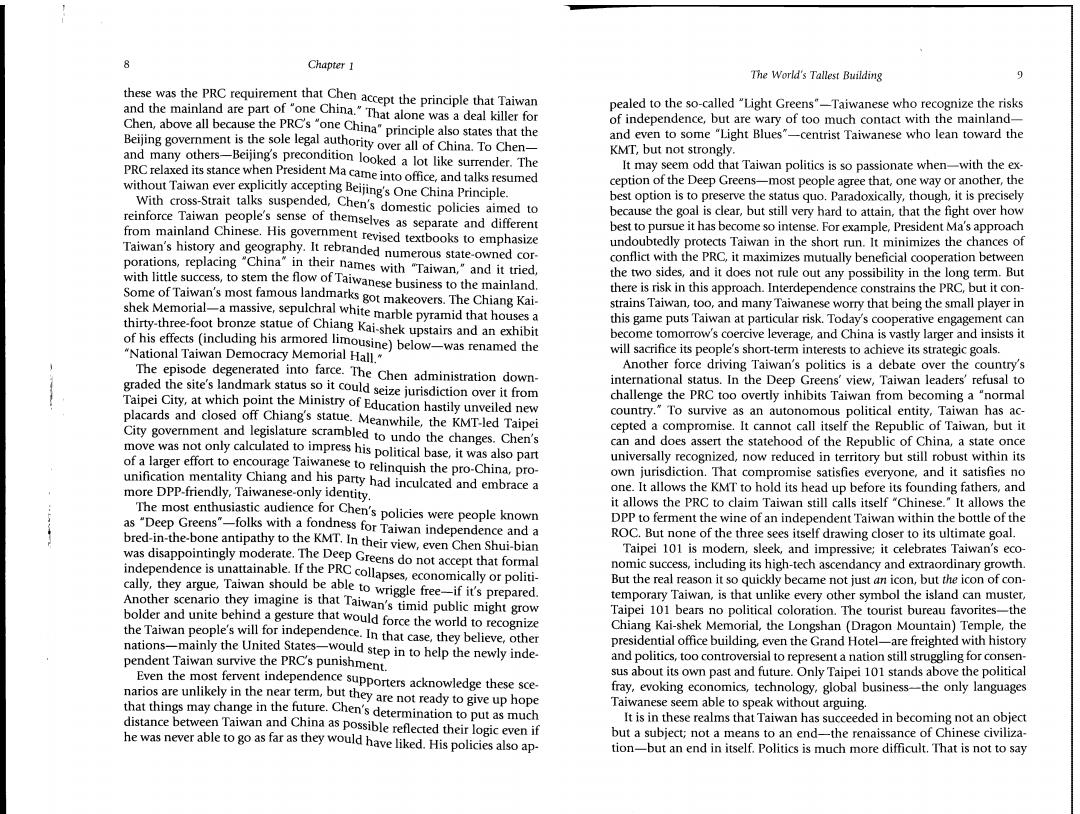
8 Chapter I The World's Tallest Building these was the PRC requirement that Chen accept the principle that Taiwan and the mainland are part of"one China."That alone was a deal killer for pealed to the so-called "Light Greens"-Taiwanese who recognize the risks Chen,above all because the PRC'sone China"principle also states that the of independence,but are wary of too much contact with the mainland- Beijing goverment is the sole legal authority over all of China.To Chen- and even to some "Light Blues"-centrist Taiwanese who lean toward the and many others-Beijing's precondition looked a lot like surrender.The KMT,but not strongly. PRCrelaxed its stance when President Ma came into office,and talks resumed It may seem odd that Taiwan politics is so passionate when-with the ex- without Taiwan ever explicitly accepting Beijing's One China Principle. ception of the Deep Greens-most people agree that,one way or another,the With cross-Strait talks suspended,Chen's domestic policies aimed to best option is to preserve the status quo.Paradoxically,though,it is precisely reinforce Taiwan people's sense of themselves as separate and different because the goal is clear,but still very hard to attain,that the fight over how from mainland Chinese.His government revised textbooks to emphasize best to pursue it has become so intense.For example,President Ma's approach Taiwan's history and geography.It rebranded numerous state-owned cor. undoubtedly protects Taiwan in the short run.It minimizes the chances of porations,replacing"China"in their names with "Taiwan,"and it tried, conflict with the PRC,it maximizes mutually beneficial cooperation between with little success,to stem the flow of Taiwanese business to the mainland. the two sides,and it does not rule out any possibility in the long term.But Some of Taiwan's most famous landmarks got makeovers.The Chiang Kai- there is risk in this approach.Interdependence constrains the PRC,but it con- shek Memorial-a massive,sepulchral white marble pyramid that houses a strains Taiwan,too,and many Taiwanese worry that being the small player in thirty-three-foot bronze statue of Chiang Kai-shek upstairs and an exhibit this game puts Taiwan at particular risk.Today's cooperative engagement can of his effects(including his armored limousine)below-was renamed the become tomorrow's coercive leverage,and China is vastly larger and insists it "National Taiwan Democracy Memorial Hall. will sacrifice its people's short-term interests to achieve its strategic goals. The episode degenerated into farce.The Chen administration down- Another force driving Taiwan's politics is a debate over the country's graded the site's landmark status so it could seize jurisdiction over it from international status.In the Deep Greens'view,Taiwan leaders'refusal to Taipei City,at which point the Ministry of Education hastily unveiled new challenge the PRC too overtly inhibits Taiwan from becoming a "normal placards and closed off Chiang's statue.Meanwhile,the KMT-led Taipei country."To survive as an autonomous political entity,Taiwan has ac- City government and legislature scrambled to undo the changes.Chen's cepted a compromise.It cannot call itself the Republic of Taiwan,but it move was not only calculated to impress his political base,it was also part can and does assert the statehood of the Republic of China,a state once of a larger effort to encourage Taiwanese to relinquish the pro-China,pro- universally recognized,now reduced in territory but still robust within its unification mentality Chiang and his party had inculcated and embrace a own jurisdiction.That compromise satisfies everyone,and it satisfies no more DPP-friendly,Taiwanese-only identity. one.It allows the KMT to hold its head up before its founding fathers,and The most enthusiastic audience for Chen's policies were people known it allows the PRC to claim Taiwan still calls itself "Chinese."It allows the as"Deep Greens"-folks with a fondness for Taiwan independence and a DPP to ferment the wine of an independent Taiwan within the bottle of the bred-in-the-bone antipathy to the KMT.In their view,even Chen Shui-bian ROC.But none of the three sees itself drawing closer to its ultimate goal. was disappointingly moderate.The Deep Greens do not accept that formal Taipei 101 is modern,sleek,and impressive;it celebrates Taiwan's eco- independence is unattainable.If the PRC collapses,economically or politi- nomic success,including its high-tech ascendancy and extraordinary growth. cally,they argue,Taiwan should be able to wriggle free-if it's prepared. But the real reason it so quickly became not just an icon,but the icon of con- Another scenario they imagine is that Taiwan's timid public might grow temporary Taiwan,is that unlike every other symbol the island can muster, bolder and unite behind a gesture that would force the world to recognize Taipei 101 bears no political coloration.The tourist bureau favorites-the the Taiwan people's will for independence.In that case,they believe,other Chiang Kai-shek Memorial,the Longshan (Dragon Mountain)Temple,the nations-mainly the United States-would step in to help the newly inde. presidential office building,even the Grand Hotel-are freighted with history pendent Taiwan survive the PRC's punishment. and politics,too controversial to represent a nation still struggling for consen- Even the most fervent independence supporters acknowledge these sce- sus about its own past and future.Only Taipei 101 stands above the political narios are unlikely in the near term,but they are not ready to give up hope fray,evoking economics,technology,global business-the only languages that things may change in the future.Chen's determination to put as much Taiwanese seem able to speak without arguing. distance between Taiwan and China as possible reflected their logic even if It is in these realms that Taiwan has succeeded in becoming not an object he was never able to go as far as they would have liked.His policies also ap- but a subject;not a means to an end-the renaissance of Chinese civiliza- tion-but an end in itself.Politics is much more difficult.That is not to say
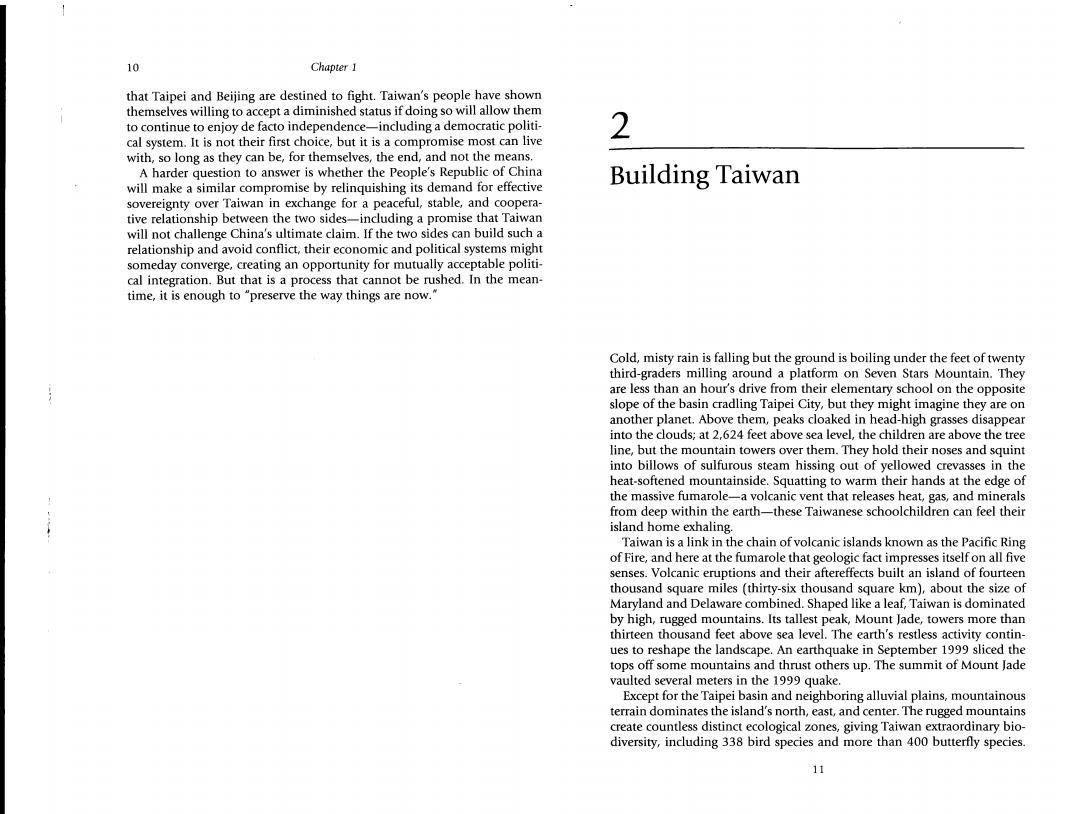
10 Chapter 1 that Taipei and Beijing are destined to fight.Taiwan's people have shown themselves willing to accept a diminished status if doing so will allow them to continue to enjoy de facto independence-including a democratic politi- 2 cal system.It is not their first choice,but it is a compromise most can live with,so long as they can be,for themselves,the end,and not the means. A harder question to answer is whether the People's Republic of China will make a similar compromise by relinquishing its demand for effective Building Taiwan sovereignty over Taiwan in exchange for a peaceful,stable,and coopera- tive relationship between the two sides-including a promise that Taiwan will not challenge China's ultimate claim.If the two sides can build such a relationship and avoid conflict,their economic and political systems might someday converge,creating an opportunity for mutually acceptable politi- cal integration.But that is a process that cannot be rushed.In the mean- time,it is enough to "preserve the way things are now." Cold,misty rain is falling but the ground is boiling under the feet of twenty third-graders milling around a platform on Seven Stars Mountain.They are less than an hour's drive from their elementary school on the opposite slope of the basin cradling Taipei City,but they might imagine they are on another planet.Above them,peaks cloaked in head-high grasses disappear into the clouds;at 2,624 feet above sea level,the children are above the tree line,but the mountain towers over them.They hold their noses and squint into billows of sulfurous steam hissing out of yellowed crevasses in the heat-softened mountainside.Squatting to warm their hands at the edge of the massive fumarole-a volcanic vent that releases heat,gas,and minerals from deep within the earth-these Taiwanese schoolchildren can feel their island home exhaling. Taiwan is a link in the chain of volcanic islands known as the Pacific Ring of Fire,and here at the fumarole that geologic fact impresses itself on all five senses.Volcanic eruptions and their aftereffects built an island of fourteen thousand square miles (thirty-six thousand square km),about the size of Maryland and Delaware combined.Shaped like a leaf,Taiwan is dominated by high,rugged mountains.Its tallest peak,Mount Jade,towers more than thirteen thousand feet above sea level.The earth's restless activity contin- ues to reshape the landscape.An earthquake in September 1999 sliced the tops off some mountains and thrust others up.The summit of Mount Jade vaulted several meters in the 1999 quake. Except for the Taipei basin and neighboring alluvial plains,mountainous terrain dominates the island's north,east,and center.The rugged mountains create countless distinct ecological zones,giving Taiwan extraordinary bio- diversity,including 338 bird species and more than 400 butterfly species. 11

12 Chapter 2 Building Taiwan 13 In sections of the northeast coast,stone cliffs fall more than three thousand In addition to the main island,which lies about 75 miles (120 kilome- feet,their descent from mountain peaks to the Pacific Ocean broken only ters)off mainland China's southeastern coast,Taiwan's political jurisdic- by a narrow notch where engineers blasted a road into the rock face in the tion extends to numerous smaller islands.The largest island group is the 1920s.Southeastern Taiwan has a narrow rift valley,beautiful and fertile, Penghu Islands (Pescadores),halfway between western Taiwan and the but remote from population centers.That leaves the island's broad western mainland.Off the east coast lie Orchid Island and Green Island,which plain as the homeland for almost 90 percent of Taiwan's 23 million people, once sported a prison where political dissidents were locked away.Nestled making it one of the world's most densely populated places. near the mainland coast are two heavily militarized "frontline islands," The Tropic of Cancer cuts through Taiwan,and the climate and veg- Jinmen (Quemoy)and Mazu (Matsu).In the 1950s,Taiwanese forces on etation are just what one would expect on a tropical island.Despite the Jinmen and Mazu exchanged fire with their counterparts on the mainland; dense human settlement,with endless apartment blocks,miles of asphalt eventually the Chinese Communist troops settled into a pattern of shell- highways,and massive landfills full of plastic refuse,nature is rarely far ing Jinmen on alternate days.The Taiwanese used the frontline islands to away.Urban neighborhoods end abruptly at near-vertical mountainsides launch propaganda messages encouraging resistance to the Communist thick with forests;trees grow from rooftops and sprouts erupt from cracked Party;they blasted away with loudspeakers and lofted balloons laden with pavement.Debris left along the roads-including wrecked cars and mo- anti-Communist messages into westbound winds.But relations have im- torcycles-quickly disappears under tangles of vines.On Roosevelt Road proved in recent years.In 2001,Taiwan opened direct travel links between in downtown Taipei,a house has been built around an enormous tree. linmen and Mazu and mainland China,making the frontline islanders the The tree begins in the sidewalk,grows through the house,and spreads its first Taiwanese in half a century to travel directly from one side to the other. canopy over a rooftop terrace.At Kaohsiung City's Sun Yat-sen University, The north-south mountain spine and shortage of navigable east-west riv- students must lock their dorm room windows to keep food-stealing mon- ers make overland transportation difficult,and the island's population is keys from the nearby jungle from breaking in. clustered near its coasts,so Taiwan's culture has a strong maritime flavor Given this verdant land,it is no surprise that agriculture has thrived Most of the island's major cities-past (Tainan,Lukang,Tamsui)and pres- in Taiwan for centuries.As early as the 1600s,Taiwan was exporting ent(Kaohsiung,Taichung,Keelung,Hualien)-are ports.Taiwan's position rice,sugar,and indigo-dyed cloth to mainland China.According to early on the trade routes connecting Northeast Asia and Southeast Asia gives it nineteenth-century reports,Xiamen (Amoy),Fujian province's largest city, a critical role in global shipping and it is an important player in the inter- depended on Taiwanese rice for most of its food supply.The island is less national fishing industry and its regulatory organizations.Taiwanese boats well-endowed when it comes to the natural resources needed for modern take about 13 percent of the global tuna catch,for example.Even religion industry.In the seventeenth century,explorers from China collected sulfur reveals this maritime orientation:Taiwan's largest popular religious sect is from the Taipei basin fumaroles to manufacture gunpowder,and the lapa- the cult of Mazu,the patron deity of seafarers.Mazu was born in Fujian nese colonial government that ruled Taiwan in the early twentieth century province in 960;she became a deity when she was credited with miraculous placed a high value on its massive camphor trees,but the island's lack of rescues at sea. fossil fuel and ore deposits forces Taiwanese to rely on imports for indus- trial raw materials. Water can be a problem,too.Taiwan has ample rainfall,but much of EARLY SETTLEMENT it comes in heavy storms and the sharp changes in elevation make flash floods,runoff,and erosion a challenge.Visitors often puzzle over the tiny The sea also brought Taiwan its human inhabitants,beginning with the streams trickling through wide,rocky riverbeds.During a summer after- ancestors of the island's Austronesian people.Today's Austronesians can be noon storm or one of Taiwan's violent typhoons,these waterways become traced to Austronesian-speaking settlers who began living in Taiwan about dangerous torrents;in 2009,Typhoon Morakot dumped more than one four thousand years ago.Over the centuries,these early islanders developed hundred inches of rain on parts of Taiwan in just four days.Even with hun- distinct languages and cultures.Taiwan's government recognizes twelve dreds of dams channeling water into reservoirs,hydroelectric plants,and groups:Atayal,Amis,Bunun,Kavalan,Paiwan,Pingpu,Puyuma,Rukai, irrigation facilities,maintaining a consistent flow is a constant challenge. Saisiyat,Tao,Thao,and Tsou.The earliest Austronesian settlements were Summer water shortages have become the norm,especially in southern located in the coastal plains,but some Austronesian groups adapted to life Taiwan. in the high mountains.The arts and culture of the different groups reflect